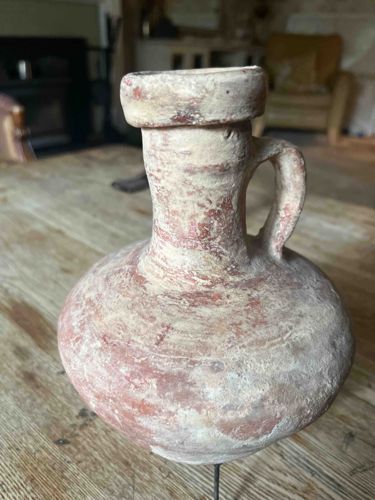
Ancient Terracotta Juglet with Single Handle
This item is an ancient terracotta juglet, likely of Mediterranean or Near Eastern origin, characterized by its globular body, narrow neck, and a single strap handle. The juglet appears to be crafted from coarse, unglazed earthenware, consistent with ancient pottery techniques. Its primary coloration is a mottled reddish-brown and off-white or cream, suggesting the original clay body and possibly remnants of a slipped or whitewashed surface that has largely worn away, revealing the reddish clay underneath. The surface shows significant wear, pitting, and calcification, indicative of prolonged burial or exposure to environmental elements. There are visible concentric lines around the body, which could be tooling marks from its creation on a potter's wheel. The handle is simply formed, attaching from the upper part of the neck to the shoulder of the body. The lip is slightly everted and thickened, forming a distinct rim. The overall condition suggests considerable age, with an uneven, textured surface and areas where the original material has eroded or discolored. No clear maker's marks or signatures are visible, which is common for ancient utilitarian pottery. The style points to a potential age ranging from the Bronze Age through the Roman period, depending on specific form factors not fully apparent in the available images. Its rustic appearance and visible imperfections attest to its handcrafted nature and historical significance. It is currently mounted on a thin, dark metal stand, indicating it is likely part of a collection or display.
AI-Generated Appraisal Disclaimer
Estimated Value
$350-600
Basic Information
Category
Ancient Pottery
Appraised On
December 14, 2025
Estimated Value
$350-600
Item Description
This item is an ancient terracotta juglet, likely of Mediterranean or Near Eastern origin, characterized by its globular body, narrow neck, and a single strap handle. The juglet appears to be crafted from coarse, unglazed earthenware, consistent with ancient pottery techniques. Its primary coloration is a mottled reddish-brown and off-white or cream, suggesting the original clay body and possibly remnants of a slipped or whitewashed surface that has largely worn away, revealing the reddish clay underneath. The surface shows significant wear, pitting, and calcification, indicative of prolonged burial or exposure to environmental elements. There are visible concentric lines around the body, which could be tooling marks from its creation on a potter's wheel. The handle is simply formed, attaching from the upper part of the neck to the shoulder of the body. The lip is slightly everted and thickened, forming a distinct rim. The overall condition suggests considerable age, with an uneven, textured surface and areas where the original material has eroded or discolored. No clear maker's marks or signatures are visible, which is common for ancient utilitarian pottery. The style points to a potential age ranging from the Bronze Age through the Roman period, depending on specific form factors not fully apparent in the available images. Its rustic appearance and visible imperfections attest to its handcrafted nature and historical significance. It is currently mounted on a thin, dark metal stand, indicating it is likely part of a collection or display.
Related Tags
Get Your Items Appraised
Instant estimates of your treasures with AI-powered instant appraisals